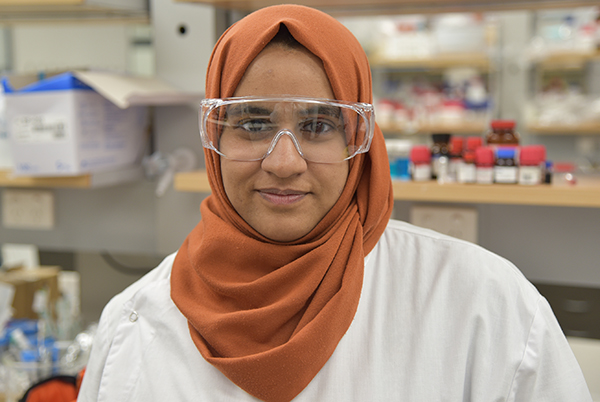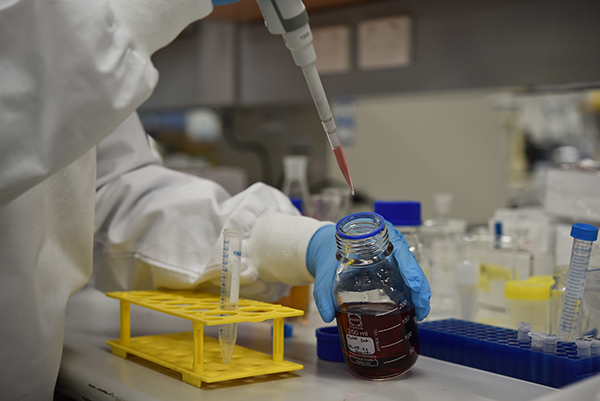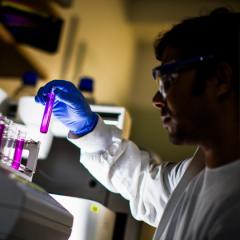
There are a few reasons why Yusra Rabbani plays around with tiny gold particles.
For one, the precious metal is central to her PhD thesis, and a key to her work at The University of Queensland, where she is developing a sensor for a new wound-monitoring ‘smart bandage’.
But when the science and study is stripped to its most basic layer, Yusra just wants to help her dad.
“Anyone who has seen the process of checking and changing a dressing on a chronic wound would have thought 'there has to be a better way to do this’,” she says.
“I have seen it in my own father. I have seen what happens when the bandages come off.”
A desire to help chronic wound patients - and to streamline the medical system that supports them – is what underpins Yusra’s research at the Australian Institute for Bioengineering and Nanotechnology (AIBN), where she has been studying for the past two years.
The gold nanoparticles she uses in her wound sensor project may not be visible to the naked eye, but the science behind her work still proved eye-catching enough at the All-Institute final of the Three-Minute Thesis this month, where she was named runner up.
The Three-Minute Thesis is an annual UQ competition where the best and brightest of the various institutes attempt to wow judges with an oral presentation on the implications of their research. The catch, as you may have guessed, is they only have three minutes to sell their story in a compelling and condensed way.
Below, Yursa explains the story behind her presentation, the science driving her wound sensor project, and why this pursuit matters to her.
---
First things first, congratulations, there’s a lot of science to fit into three minutes. How do you get such a big idea into such a compact package?
In science, it is very important to be able to express what you are doing and how you are doing it very clearly, and also make use of presentation skills. What is happening in these labs, it can be very difficult to describe to a layman without getting too complex. But on the other side, you shouldn’t be downplaying or patronising to the audience. It is a very fine line you are walking and you need to try and get it right. I got a lot of motivation and inspiration from colleagues in the Blakey Group and of course my supervisor Associate Professor Idriss Blakey.
Right so let's test that out. In a nutshell, tell us about your smart bandage and the gold particles.
In a nutshell, I am designing a sensor that will be able to monitor chronic wounds. Eventually, I am hoping that this sensor will be able to be embedded in a bandage. But for now it is just the sensor.
The sensor I am designing will be able to pick up changes that happen in the wound environment. What I am targeting are Reactive Oxygen Species (ROS). These are highly reactive particles that are particularly volatile around a wound, and their movement plays a big role in how the wound heals.
I want to be able to monitor these ROS so we can see if a wound needs a specific kind of care or not.

What do you mean by specific care? Is that just keeping the wound clean and dressed?
Think about the process: You remove the bandage, you look at the wound, you measure it, you analyse it and then you decide that it needs more time to heal. What we’re trying to do is minimise that removal of bandage, and therefore minimise the visits to hospital.
Every one of us has someone in the family or friends circle who has a chronic wound, or even a post operatic wound and they often need to visit the clinic for its upkeep and cleanliness.
So where does the gold come in?
The wound detection method is another aspect of what we’re doing with the sensor. We’re using ramanspectroscopy. It’s a detection technique that is not used as much. It sounds like ‘ramen noodles’ which is how a lot of people remember it.
Every single chemical or molecule has a little bit of vibration. You can’t really feel it or detect it. What we are doing is using ramanspectroscopy trying to amplify those vibrations in the ROS so we can feel them and detect them without taking off the bandage.
That’s where the gold nanoparticles come in. When we bring together gold or silver nanoparticles close together they help amplify that signal, the ‘raman’ effect.
In my sensor, I’ve got little assemblies where the gold and silver nanoparticles are close together, and when those ROS I am looking for come into the nanogaps, the signal suddenly spikes.
Initially I am working on a monitoring aspect, but if my PhD allows, or if we can work with some other collaborators, we would like to develop a therapeutic aspect where we also load a drug into the bandage to help with the healing process.
Is this kind of science already being used?
A lot of researchers nowadays are looking at how we enhance those ROS signals. It’s being used not just in a biological sense – it is being used by defence forces and people detecting explosives and drugs and narcotics.
This is being used by a lot of different fields. When it comes to the biological applications... the thing is, wounds will always be there. People will always get hurt.
My father, who is in Pakistan, suffers from diabetes, and has severe skin allergies, so he often gets wounds, cuts because his skin is much more sensitive than other people’s. And sometimes he gets diabetic ulcers.
I’ve seen his journey and what he has gone through, and it was definitely painful and uncomfortable and it takes a lot of time to make those journeys back and forth.
So I thought why not do something to help. At least, if it is not in time for my father, it can help someone else like him.

How many people like your father would benefit from one of your smart bandages?
In Australia there 420,000 people with Chronic wounds each year. And $3 billion is spent in Australia each year. These are huge numbers
Also, money is one thing, but time is another. Imagine the time that is used up in medical clinics, the waiting time, nurses’ time, the doctors’ time... These are things that could be rectified.
That is the motivation I have. Anyone who has seen the process of checking and changing a dressing on a chronic wound would have thought 'there has to be a better way to do this’
I have seen it in my own father. I have seen what happens when the bandages come off.
What does your father say about your work?
My father – who was a medical professional himself – was joking around with me, saying, “See! I am still inspiring you! You still need me!”
I suppose it is not easy to take something negative and turn it into a positive. But there are always going to be some negative things. So you need to find a way to turn it into a positive.
With this sort of thing you need to have a real passion for the work you are doing, otherwise when things get hard with your work, you are left wondering why am I doing this?
At the end of the day I feel like you do need to try and make a difference in the world.
You can meet more of our incredible researchers by clicking through here.


